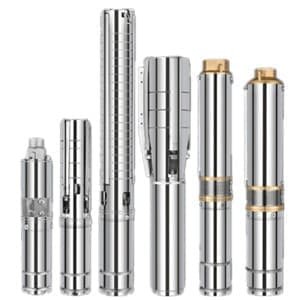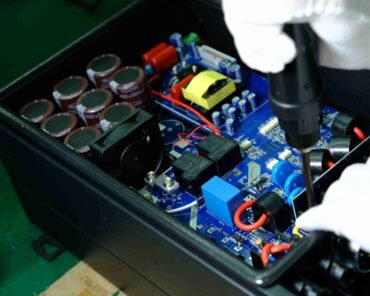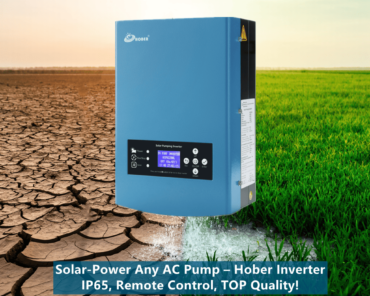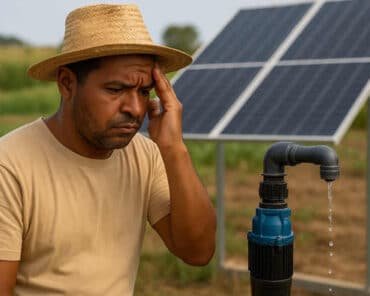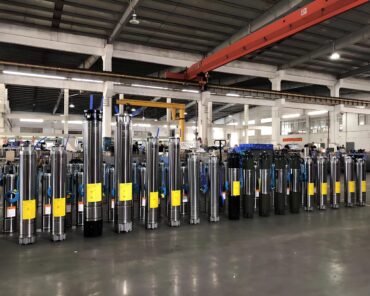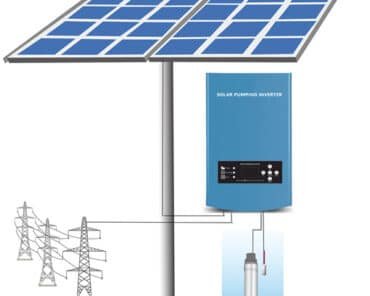La guía completa para elegir la bomba solar de pozo profundo adecuada a sus necesidades
Ver cómo mis cultivos se marchitaban durante la temporada seca era desgarrador, hasta que descubrí cómo las bombas solares de pozo profundo podían transformar mi finca. Tras varias instalaciones, he recopilado todo lo necesario para elegir la bomba perfecta.
La bomba solar para pozo profundo adecuada se adapta a la profundidad del pozo, las necesidades diarias de agua y la luz solar disponible. Las consideraciones clave incluyen el cálculo de la carga dinámica total, el dimensionamiento adecuado del sistema solar y la elección entre bombas sumergibles o de superficie. Un sistema dimensionado correctamente puede suministrar más de 10 000 litros diarios sin gastar nada en combustible.
[Campo de riego con bomba solar]
Esta guía completa recorre mi probado proceso de selección de siete pasos, con tablas detalladas, ejemplos del mundo real y consejos de mantenimiento de mi trabajo de campo en el este de África.
Cómo evaluar con precisión sus necesidades de agua
Muchos agricultores subestiman sus necesidades reales de agua. Aquí te explicamos cómo calcular las tuyas con precisión:
Paso 1: Determinar la demanda básica de agua
| Aplicación | Método de cálculo | Ejemplo |
| Hogar | 50 litros por persona × tamaño de la familia | Familia de 5 = 250L/día |
| Ganado | Vacas: 40L/día Cabras: 5L/día Pollos: 0,5L/día | 10 vacas + 20 cabras = 500L/día |
| Riego | Tipo de cultivo × área 1 acre de hortalizas = 4.000L/día |
Paso 2: Tenga en cuenta el uso máximo
- Multiplicar las necesidades básicas por 1,5 el factor de seguridad
- Ejemplo: (250L + 500L + 4000L) × 1,5 = 7.125L/día
Tabla de necesidades de agua de los cultivos
| Tipo de cultivo | Necesidad de agua (L/día/acre) | Temporada de crecimiento |
| Verduras | 3.000-5.000 | Todo el año |
| Maíz | 1.500-2.500 | Temporada de lluvias |
| Café | 2.000-3.500 | Estación seca |
| Huerto | 1.000-2.000 | Todo el año |
Cómo medir correctamente las características de su pozo
He visto numerosas instalaciones fallidas debido a mediciones incorrectas del pozo. Siga este método profesional:
Protocolo de medición de pozos
- Nivel de agua estático: Medir desde el suelo hasta la superficie del agua durante el período sin bombeo.
- Prueba de reducción:Registre el nivel de agua después de 1 hora de bombeo continuo
- Tasa de recuperación:Es hora de que el agua vuelva al nivel estático después de que la bomba se detenga
Herramientas recomendadas
- Medidor de nivel de agua eléctrico (precisión de ±1 cm)
- Cinta métrica manual con peso
- Equipos de prueba de bombas para instalaciones profesionales
Guía de clasificación de pozos
| Profundidad | Tipo de bomba | Costo típico |
| 0-30m | Bomba de superficie | $500-$1,500 |
| 30-80m | Sumergible para pozos poco profundos | $800-$2,000 |
| 80-150m | Sumergible para pozos profundos | $1,500-$3,500 |
| 150m+ | Pozo profundo especializado | $3,000+ |
La forma correcta de calcular la carga dinámica total (CDT)
La mayoría de los proveedores simplifican este cálculo crítico: no permita que le engañen:
Componentes del TDH
- Elevación vertical (nivel de agua estático + descenso)
- Pérdida por fricción en tuberías (depende de la longitud/diámetro)
- Requisitos de presión (para rociadores/filtración)
Tabla de referencia de pérdida por fricción
| Diámetro de la tubería | Caudal | Pérdida por fricción por 100 m |
| 1" | 5m³/h | 15m de altura |
| 1,5" | 10 m³/h | 8 m de altura |
| 2" | 15m³/h | 5m de altura |
Fórmula completa de TDH
TDH = Elevación vertical + Pérdida de fricción + Requisitos de presión + Margen de seguridad (10%)
Ejemplo de cálculo:
- Profundidad del pozo: 60m
- Caída: 10m
- Tubería: 200m de PVC de 1,5"
- Los aspersores necesitan una presión de 20 m.
- Cálculo: 70 m + (8 m × 2) + 20 m = 106 m × 1,1 = 116,6 m TDH
Componentes del sistema de bombeo solar explicados
Después de instalar 47 sistemas, esto es lo que realmente importa en cada componente:
1. Comparación de tipos de bombas
| Tipo | Rango de profundidad | Eficiencia | Mantenimiento |
| Superficie | 0-7m | 30-50% | Alto |
Sumergible | 7-250m | 60-75% | Bajo |
| DC sin escobillas | Cualquiera | 70-85% | Muy bajo |
2. Selección del controlador solar
| Tipo | Eficiencia | Mejores aplicaciones | Costo |
| PWM | 70-75% | Sistemas pequeños (<1,5 kW) | $50-$150 |
| MPPT | 93-97% | La mayoría de los usos agrícolas | $200-$600 |
| Frecuencia variable | 95%+ | Gran comercial | $1,000+ |
3. Pautas de configuración del panel
| Tamaño de la bomba | Necesidad diaria de agua | Paneles recomendados |
| 0,5 HP | <5000 L | 4×300 W |
| 1 HP | 5000-10 000 L | 6×400 W |
| 2 HP | 10 000-20 000 L | 10×450 W |
| 3 HP | 20 000 L+ | 15×500 W |
Mantenimiento: Lo que la mayoría de los proveedores no le dirán
Según mi experiencia de campo, estas prácticas de mantenimiento duplican la vida útil de la bomba:
Lista de verificación mensual
✔ Limpiar los paneles solares con un cepillo suave
✔ Verifique las conexiones de las tuberías para detectar fugas
✔ Pruebe la calidad del agua (arena/sedimentos)
✔ Monitorear las horas de funcionamiento de la bomba
Mantenimiento anual
- Inspección completa del sistema
- Lubricación de cojinetes (si corresponde)
- Actualizaciones del firmware del controlador
- Limpieza de tuberías
Instalación en el mundo real: Ejemplo de sistema de 2 HP
Detalles del proyecto:
- Ubicación: Granja de maíz, Tanzania
- Profundidad del pozo: 85m
- Necesidad de agua: 15.000L/día
- Solución: Bomba sumergible Hober 2HP (H4SP8-150)
- Sistema solar: 8 paneles de 450 W sobre un seguidor
- Almacenamiento: Tanque de 5.000L + riego por goteo
Datos de rendimiento:
- Caudal: 10 m³/h (7 horas de funcionamiento)
- Ahorro de combustible: $150/mes vs diésel
- Periodo de retorno de la inversión: 22 meses
- Estado actual: Funcionando 3 años con solo 1 servicio
Solución de problemas comunes
Problema 1: Baja producción de agua
Posibles causas:
- Impulsor obstruido (limpiar con solución de vinagre)
- Tuberías de tamaño insuficiente (actualizar a un diámetro mayor)
- Sombreado de paneles (vegetación recortada)
Problema 2: Paradas frecuentes
Soluciones:
- Instalar protección contra funcionamiento en seco
- Añadir estabilizador de voltaje
- Compruebe si hay fallas en el cableado
Conclusión: Cómo tomar la decisión final
Elegir la bomba de agua solar perfecta requiere un análisis minucioso de sus necesidades específicas. Recuerde estos puntos clave:
- Mida dos veces: calcule las necesidades de agua y las especificaciones del pozo con precisión
- Invierta en calidad: los mejores componentes duran entre 5 y 10 años más
- Planifique la expansión: prepare su sistema para el futuro
- El mantenimiento es importante: un cuidado sencillo evita reparaciones costosas
¿Listo para implementar? Utilice esta lista de verificación:
- Evaluación de necesidades de agua completada
- Mediciones de pozos verificadas
- TDH calculado
- Tipo de bomba apropiado seleccionado
- Panel solar diseñado
- Logística de instalación planificada
Para recomendaciones personalizadas, ofrezco consultas gratuitas para revisar los detalles de su proyecto y sugerir configuraciones óptimas basadas en mi experiencia de campo.


